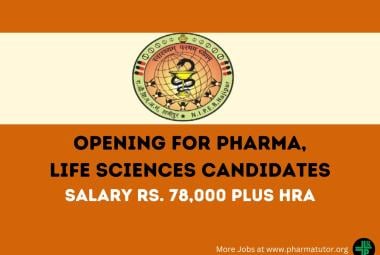About Authors:
Karmveer Tomar
B. Pharmacy, MBA(POM)
Asst. Production Manager.
Introduction:
WHO defines Good Manufacturing Practices (GMP) as “that part of quality assurance which ensures that products are consistently produced and controlled to the quality standards appropriate to their intended use and as required by the marketing authorization.” GMP covers all aspects of the manufacturing process: validated critical manufacturing steps; approved written procedures and instructions; records to show all steps of defined procedures have been taken. The guiding principle of GMP is that quality is built in to a product, and not just tested in to a product. Therefore, the assurance is that the product not only meets the final specifications, but that it has been made by the same procedures under the same conditions each and every time it is made. There are many ways this is controlled – validation is that part of GMP that ensures that facility systems, equipment, processes, and tests procedures are in control and therefore consistently produce quality product.
[adsense:336x280:8701650588]
Four Basic Element of GMP: 4Ms
*Men: adequate training
*Materials: raw materials, products, reagents labels, containers
*Machinery: facilities, systems, equipment
*Methods: manufacturing, control, validation, documentation
Validation is the process of evaluating products or analytical methods to ensure compliance with products or cleaning method requirements. Validation is a concept that has been evolving continuously since its first formal appearance in 1978 in USA.
Validation (USFDA) is defined as the establishing of documented evidence which provides a high degree of assurance that a planned process will consistently perform according to the intended specified outcomes. Validation studies are performed for analytical tests, equipment, facility systems such as air, water, steam, and for processes such as the manufacturing processes, cleaning, sterilization, sterile filling, lyophilization, etc. There will be a separate validation for the lyophilizer as an equipment item and for the lyophilization process; for the cleaning of glassware and the cleaning of the facility; and for the sterilization process and for the sterility test. Every step of the process of manufacture of a drug product must be shown to perform as intended. Validation studies verify the system under test under the extremes expected during the process to prove that the system remains in control. Once the system or process has been validated, it is expected that it remains in control, provided no changes are made. In the event that modifications are made, or problems occur, or equipment is replaced or relocated, revalidation is performed. Critical equipment and processes are routinely revalidated at appropriate intervals to demonstrate that the process remains in control.
The validity of systems/equipment/tests/processes can be established by prospective, concurrent or retrospective studies.
1. Prospective validation is data collected based on a pre-planned protocol. It is carried out during the development stages and it is result of a risk analysis on the production process.
2. Concurrent validation; it is form of validation carried out during the normal production.
3. Retrospective validation; validation based on historical and testing data of previously manufactured batches.
4. Revalidation; is needed to assure that changes in process environment, whether introduced intentionally or unintentionally, do not adversely affect process characteristics and produce quality.
Types of Validations:Process validation(21CFR211.220) and method validation(21CFR211.222) are two major types recognized. But Cleaning method and utility validations are also another type to be considered for validations.
Process Validationis establishment and performance of activities required to obtain documented assurance that a manufacturing process or a part thereof- during routine use are correct so that specified requirements on process variables and product properties are compiled with.
Validation activities that centers on equipment, machine rather than process is referred as qualifications.
Qualification: A phase of validation that provide documented verification that any system or equipment works correctly leads to the expected results. Qualifications are divided in to four parts. These are:
I. Design Qualifications (DQ). II. Installation Qualifications (IQ). III. Operational Qualifications (OQ). IV. Performance Qualifications (PQ).
Validation Lifecycle: Steps involved in Validation Process are:
1. Validation master plan
2. Validation protocol
3. Execution of validation
4. Validation report
5. Preparation of SOPs
Master Validation Plan: It is a document pertaining to the whole facility that describe which will be validated by whom and when. It also provide standards . It also indicate why and when it should be revalidate.
Statutory and Regulatory Requirements for Process Validation:
Process validation for drugs is a legally enforceable requirement under section 501(a)(2)(B) of the Act, which states the following:
A drug shall be deemed to be adulterated if the methods used in, or the facilities or controls used for, its manufacture, processing, packing or holding do not conform to or are not operated or administered in conformity with cGMP to assure that such drugs meets the requirements of this act as to safety and has the identity & strength and meets the quality & purity characteristics, which it purports or is represented to possess.
Importance of Validation :
Validation assures a great importance for – Quality Assurance and cost reduction. Validation produces product fit for intended use. Quality; Safety and Effectiveness may be designed and built in to product.
Validation is key element in assuming the quality of the product. In this way Validation is an important tool of GMP.
References:
1. A WHO guide to good manufacturing practice (GMP) requirements Part 2 Validation by G. C. Larsoon Ph.D.,Roger Anderson Ph. D., Anik Egan Bioconsult Ottawa.
2. Principles of Process Validation & Qualification by Seunghwa Hong Ph. D. Korea FDA July 16, 2003
3. Guidance for Industries, Process Validation: general Principle & Practices USFDA Website: www.fda.gov./cder/guidance/index.htm
4. Pharma Pathway Eighth Revised Edition By D. A. Sawant (Wockhardt Ltd. Aurangabad).
Reference ID: PHARMATUTOR-ART-1007










